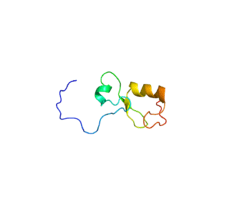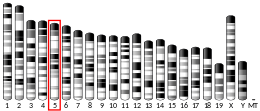RNF4
RING finger protein 4 is a protein that in humans is encoded by the RNF4 gene.[5][6]
The protein encoded by this gene contains a RING finger domain and acts as a transcription factor. This protein has been shown to interact with, and inhibit the activity of, TRPS1, a transcription suppressor of GATA-mediated transcription. Transcription repressor ZNF278/PATZ1 is found to interact with this protein, and thus reduce the enhancement of androgen receptor-dependent transcription mediated by this protein. Studies of the mouse and rat counterparts suggested a role of this protein in spermatogenesis.[6]
Interactions
RNF4 has been shown to interact with TCF20,[7] PATZ1[8][9] and Androgen receptor.[9][10][11]
gollark: Well, Katze, it's a rareish with a cool code, not THAT bad.
gollark: I do! I'm just bad at it.
gollark: I need to figure out how to get aeons, that is a good offer.
gollark: An error is always a problem!
gollark: Biscuit is a communication.
See also
References
- GRCh38: Ensembl release 89: ENSG00000063978 - Ensembl, May 2017
- GRCm38: Ensembl release 89: ENSMUSG00000029110 - Ensembl, May 2017
- "Human PubMed Reference:". National Center for Biotechnology Information, U.S. National Library of Medicine.
- "Mouse PubMed Reference:". National Center for Biotechnology Information, U.S. National Library of Medicine.
- Chiariotti L, Benvenuto G, Fedele M, Santoro M, Simeone A, Fusco A, Bruni CB (Jan 1998). "Identification and characterization of a novel RING-finger gene (RNF4) mapping at 4p16.3". Genomics. 47 (2): 258–65. doi:10.1006/geno.1997.5105. PMID 9479498.
- "Entrez Gene: RNF4 ring finger protein 4".
- Lyngsø C, Bouteiller G, Damgaard CK, Ryom D, Sanchez-Muñoz S, Nørby PL, Bonven BJ, Jørgensen P (Aug 2000). "Interaction between the transcription factor SPBP and the positive cofactor RNF4. An interplay between protein binding zinc fingers". The Journal of Biological Chemistry. 275 (34): 26144–9. doi:10.1074/jbc.M003405200. PMID 10849425.
- Fedele M, Benvenuto G, Pero R, Majello B, Battista S, Lembo F, Vollono E, Day PM, Santoro M, Lania L, Bruni CB, Fusco A, Chiariotti L (Mar 2000). "A novel member of the BTB/POZ family, PATZ, associates with the RNF4 RING finger protein and acts as a transcriptional repressor". The Journal of Biological Chemistry. 275 (11): 7894–901. doi:10.1074/jbc.275.11.7894. PMID 10713105.
- Pero R, Lembo F, Palmieri EA, Vitiello C, Fedele M, Fusco A, Bruni CB, Chiariotti L (Feb 2002). "PATZ attenuates the RNF4-mediated enhancement of androgen receptor-dependent transcription". The Journal of Biological Chemistry. 277 (5): 3280–5. doi:10.1074/jbc.M109491200. PMID 11719514.
- Moilanen AM, Poukka H, Karvonen U, Häkli M, Jänne OA, Palvimo JJ (Sep 1998). "Identification of a novel RING finger protein as a coregulator in steroid receptor-mediated gene transcription". Molecular and Cellular Biology. 18 (9): 5128–39. doi:10.1128/mcb.18.9.5128. PMC 109098. PMID 9710597.
- Poukka H, Aarnisalo P, Santti H, Jänne OA, Palvimo JJ (Jan 2000). "Coregulator small nuclear RING finger protein (SNURF) enhances Sp1- and steroid receptor-mediated transcription by different mechanisms". The Journal of Biological Chemistry. 275 (1): 571–9. doi:10.1074/jbc.275.1.571. PMID 10617653.
Further reading
- Moilanen AM, Poukka H, Karvonen U, Häkli M, Jänne OA, Palvimo JJ (Sep 1998). "Identification of a novel RING finger protein as a coregulator in steroid receptor-mediated gene transcription". Molecular and Cellular Biology. 18 (9): 5128–39. doi:10.1128/mcb.18.9.5128. PMC 109098. PMID 9710597.
- Hadano S, Ishida Y, Ikeda JE (Jun 1998). "The primary structure and genomic organization of five novel transcripts located close to the Huntington's disease gene on human chromosome 4p16.3". DNA Research. 5 (3): 177–86. doi:10.1093/dnares/5.3.177. PMID 9734812.
- Poukka H, Aarnisalo P, Santti H, Jänne OA, Palvimo JJ (Jan 2000). "Coregulator small nuclear RING finger protein (SNURF) enhances Sp1- and steroid receptor-mediated transcription by different mechanisms". The Journal of Biological Chemistry. 275 (1): 571–9. doi:10.1074/jbc.275.1.571. PMID 10617653.
- Fedele M, Benvenuto G, Pero R, Majello B, Battista S, Lembo F, Vollono E, Day PM, Santoro M, Lania L, Bruni CB, Fusco A, Chiariotti L (Mar 2000). "A novel member of the BTB/POZ family, PATZ, associates with the RNF4 RING finger protein and acts as a transcriptional repressor". The Journal of Biological Chemistry. 275 (11): 7894–901. doi:10.1074/jbc.275.11.7894. PMID 10713105.
- Galili N, Nayak S, Epstein JA, Buck CA (May 2000). "Rnf4, a RING protein expressed in the developing nervous and reproductive systems, interacts with Gscl, a gene within the DiGeorge critical region". Developmental Dynamics. 218 (1): 102–11. doi:10.1002/(SICI)1097-0177(200005)218:1<102::AID-DVDY9>3.0.CO;2-A. PMID 10822263.
- Lyngsø C, Bouteiller G, Damgaard CK, Ryom D, Sanchez-Muñoz S, Nørby PL, Bonven BJ, Jørgensen P (Aug 2000). "Interaction between the transcription factor SPBP and the positive cofactor RNF4. An interplay between protein binding zinc fingers". The Journal of Biological Chemistry. 275 (34): 26144–9. doi:10.1074/jbc.M003405200. PMID 10849425.
- Häkli M, Karvonen U, Jänne OA, Palvimo JJ (Jun 2001). "The RING finger protein SNURF is a bifunctional protein possessing DNA binding activity". The Journal of Biological Chemistry. 276 (26): 23653–60. doi:10.1074/jbc.M009891200. PMID 11319220.
- Saville B, Poukka H, Wormke M, Janne OA, Palvimo JJ, Stoner M, Samudio I, Safe S (Jan 2002). "Cooperative coactivation of estrogen receptor alpha in ZR-75 human breast cancer cells by SNURF and TATA-binding protein". The Journal of Biological Chemistry. 277 (4): 2485–97. doi:10.1074/jbc.M109021200. PMID 11696545.
- Pero R, Lembo F, Palmieri EA, Vitiello C, Fedele M, Fusco A, Bruni CB, Chiariotti L (Feb 2002). "PATZ attenuates the RNF4-mediated enhancement of androgen receptor-dependent transcription". The Journal of Biological Chemistry. 277 (5): 3280–5. doi:10.1074/jbc.M109491200. PMID 11719514.
- Yan W, Hirvonen-Santti SJ, Palvimo JJ, Toppari J, Jänne OA (Oct 2002). "Expression of the nuclear RING finger protein SNURF/RNF4 during rat testis development suggests a role in spermatid maturation". Mechanisms of Development. 118 (1–2): 247–53. doi:10.1016/S0925-4773(02)00261-7. PMID 12351196.
- Pero R, Lembo F, Chieffi P, Del Pozzo G, Fedele M, Fusco A, Bruni CB, Chiariotti L (Sep 2003). "Translational regulation of a novel testis-specific RNF4 transcript". Molecular Reproduction and Development. 66 (1): 1–7. doi:10.1002/mrd.10322. PMID 12874792.
- Kaiser FJ, Möröy T, Chang GT, Horsthemke B, Lüdecke HJ (Oct 2003). "The RING finger protein RNF4, a co-regulator of transcription, interacts with the TRPS1 transcription factor". The Journal of Biological Chemistry. 278 (40): 38780–5. doi:10.1074/jbc.M306259200. PMID 12885770.
- Lin DY, Fang HI, Ma AH, Huang YS, Pu YS, Jenster G, Kung HJ, Shih HM (Dec 2004). "Negative modulation of androgen receptor transcriptional activity by Daxx". Molecular and Cellular Biology. 24 (24): 10529–41. doi:10.1128/MCB.24.24.10529-10541.2004. PMC 533990. PMID 15572661.
External links
- RNF4+protein,+human at the US National Library of Medicine Medical Subject Headings (MeSH)
This article is issued from Wikipedia. The text is licensed under Creative Commons - Attribution - Sharealike. Additional terms may apply for the media files.




